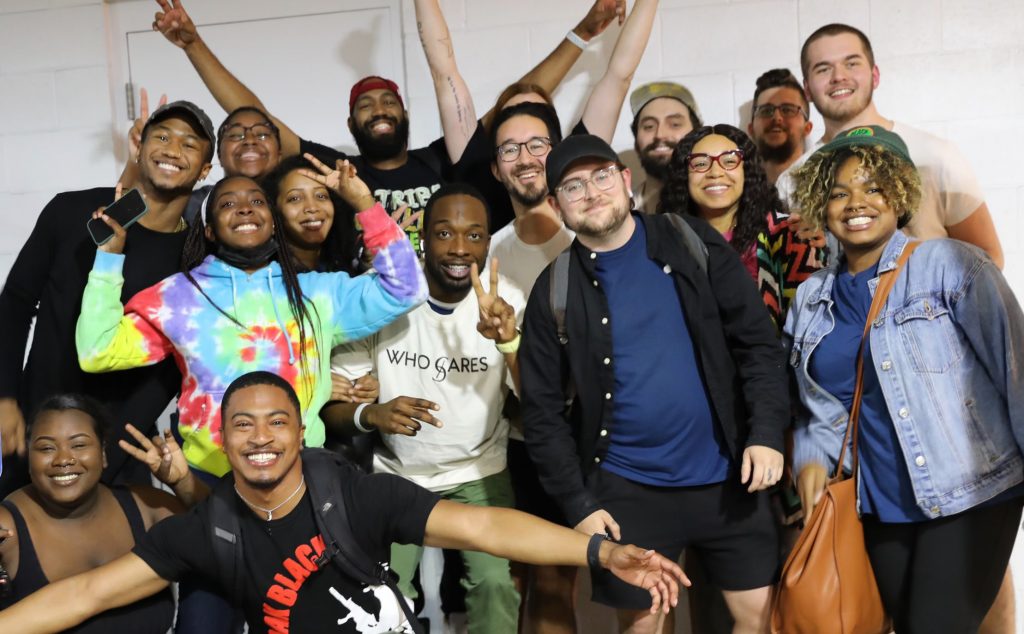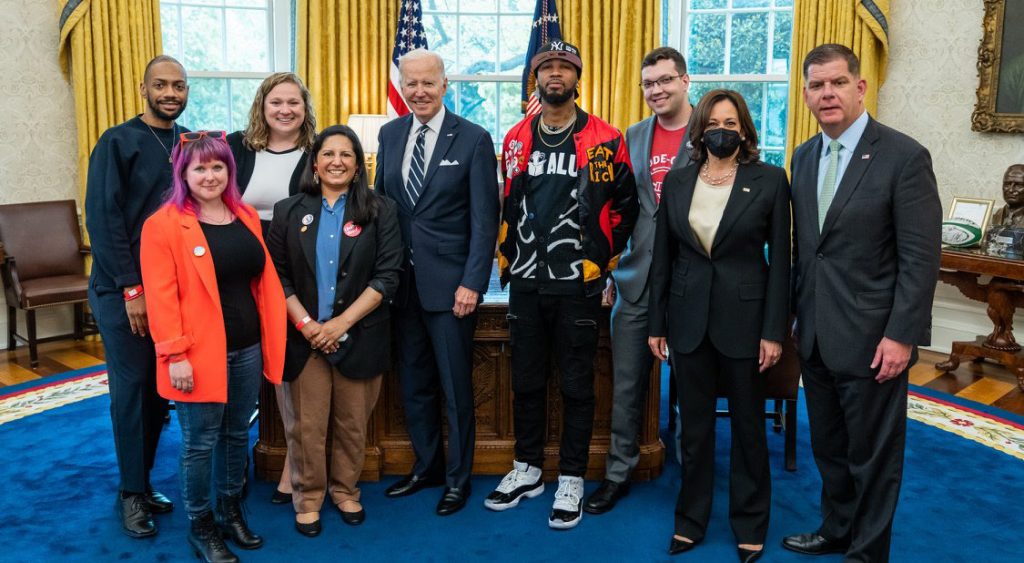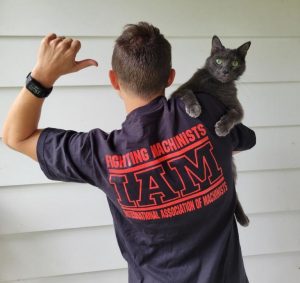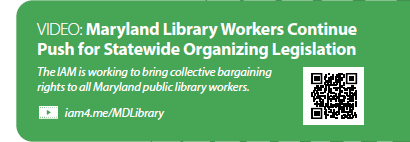

–This story is from the Summer 2023 edition of the IAM Journal
Demand for union representation has surged in recent years with the COVID-19 pandemic certainly playing a key role in exposing disparities and accelerating the push by white-collar workers and other workers to organize. Labor shortages gave workers a rare leg up, which workers are using to seek higher pay and better benefits from employers.
Stagnant wages, job security, role transparency, working conditions, and a voice at work are all workplace issues that these workers are trying to address through unionizing and collective bargaining.
IAM Core members celebrate their historic victory to organize the very first Apple Store in Towson, MD.The IAM has launched organizing campaigns in non-traditional industries, such as technology, academia, service, and have become the face of growing the strength of the IAM and working families. These typically younger workers are comfortable using digital communication tools to discuss issues and organize their workplaces.
But organizing new workers remains difficult to do even as unions are experiencing rising popularity. A Gallup poll found that 71% of Americans said they approve of labor unions, the highest percentage recorded in more than 50 years. Still many companies hire union busting firms to thwart worker’s efforts to unionize their workplaces. Also, because they work in industries that have a long history of being averse to unions, these workers face well-organized and well-funded union-busting campaigns when they try to organize.
Most workers care deeply about what is in their union contract—not just how much they are paid or what recourses they have for when they are treated unfairly by management but also a wide range of issues, such as health and safety, schedules and hours, whether they may retire, and everything in between.

IAM Core members celebrate their historic victory to organize the very first Apple Store in Towson, MD.
There’s a misconception that more educated, white-collar workers unilaterally have higher pay, better working conditions, and more job security than blue-collar workers.
But it’s becoming a common refrain that white-collar workers are becoming increasingly dissatisfied with how they are treated in the workplace and are more supportive of labor unions.
Workers in union outlier industries are taking notice of the organizing success of the IAM and what once seemed unlikely or impossible has become achievable. Union organizing victories can be very contagious.
The Machinists have led the way in non-traditional organizing – or organizing outside the box. The IAM’s Eastern Territory is in the forefront of a new organizing strategy, and when they organized the Maine Lobstermen, it was just the beginning.
“The Eastern Territory has a few organizing wins that were really out the box,” said Eastern Territory General Vice President David Sullivan. “It really started with the Lobstermen, a very nontraditional industry, to more recently the Vet Techs, the Baltimore County Public Librarians, the retail workers of IAM CORE, and the employees of Architectural Workers United, the Eastern Territory continues to press forward in these nontraditional industries.”
“The pandemic proved that the only way for workers to actually have a voice, to have a say on the job, is to join a union,” continued Sullivan. “Across the country workers are saying, we want more, we want better and the only way to do that is through a strong union contract.”
Baltimore County Public Librarians
Nearly 500 full and part-time Baltimore County Public Library (BCPL) employees at the administrative office and the 19 county library branches who organized with the IAM have also voted to ratify their first union contract. The one-year collective bargaining agreement includes pay increases and paid leave, among other significant improvements.

IAM member and Baltimore County Public Library employee Jaimie Caldwell met at the White House with President Biden, Vice President Kamala Harris, U.S. Labor Secretary Marty Walsh, and other members of the White House Task Force on Worker Organizing and Empowerment. The meeting took place in May 2022.
The first contract with BCPL comes after years of organizing, including the IAM pursuing a new state law allowing BCPL employees to collectively bargain. In April 2021, several Maryland General Assembly legislators drafted and passed legislation, supported by workers and union officials, allowing BCPL staff to collectively bargain. The bill stated that after union organizers collect signatures from 30% of a library systems employees, then at least 50% have to vote in favor of joining a union before negotiations with the library administration begins.

The IAM is also supporting legislation sponsored by Maryland State Del. Steve Johnson (D-34A), and Senator Nancy King (D-39), that would provide a consistent process for employees of unorganized public library systems in Maryland to form a union and collectively bargain.
“I feel a lot of optimism and excitement for the future of unionization of library workers, in Maryland,” said BCPL United Chief Steward Rachael Moorshead. “I think we are just at the beginning of what could be a great increase in the rights, and protections for library workers across the state.”

“Although our organizing effort began before the pandemic, it was a big wake up call for us in terms of the power BCPL has over what we were being asked to do on a daily basis, continued Moorshead. “We felt they were asking us to return to the branches before we were comfortable with it and we had no recourse to negotiate.”
“It’s all about the seat at the table,” said BCPL United President Anita Bass. “We don’t have to wait until negotiations to talk with management to work out our concern and issues. We can bring our issues to the table outside of negotiations and that is very empowering.”
Veterinary Specialists and Emergency Services
Workers at Veterinary Specialists and Emergency Services (VSES) in Rochester, NY, made history when they overwhelmingly voted to join the IAM in 2022, becoming the first Veterinary Hospital to unionize on the east coast. But it didn’t come easy.

Sam Estes, Veterinary Specialists and Emergency Services employee and a satisfied customer.
After the employees of VSES voted for representation by the IAM, Thrive Pet Healthcare, VSES’s corporate owner, initially chose to fight the election result rather than bargain, but chose to abandon its legal appeals, and the IAM now looks forward to negotiating a fair and equitable collective bargaining agreement for the workers.
This grassroots campaign had been several months in the making. Some of the significant issues for Veterinary Specialists and Emergency Services workers included unfair working conditions, including understaffing and stagnant wages, despite rising costs for pet medical procedures. The effort was successful in part due to a partnership with Liz Hughston, president of the National Veterinary Professionals Union (NVPU).
 The unit of workers is made up of licensed veterinary technicians, veterinary assistants, front desk staff, and other critical staff that has begun to bargain for their first contract.
The unit of workers is made up of licensed veterinary technicians, veterinary assistants, front desk staff, and other critical staff that has begun to bargain for their first contract.
“I think there is a big disconnect,” said VSES Shop Steward Sam Estes. “With the corporate buyout of our practice, the people making the decisions are no longer in the building, and they don’t see the impact it has on people and their pets.”
“I think Veterinary Medicine in general has needed representation for a long time,” said VSES Shop Steward Tara McGrain. “Now that I’ve had the experience of organizing, I learned this is where we should be. Before we organized our input didn’t really matter.”
IAM CORE
 The International Association of Machinists and Aerospace Workers’ (IAM) Coalition of Organized Retail Employees (IAM CORE), organized the first Apple workers to join a union in 2022. However, Apple has been adversarial from the start, first by using organizing busting tactics, as well as withholding benefits from organized workers that other workers were getting. IAM Core filed an Unfair Labor Practice charge at the National Labor Relations Board (NLRB) against Apple for excluding IAM CORE members in Towson, MD. from certain educational and medical benefits being offered to all other Apple employees.
The International Association of Machinists and Aerospace Workers’ (IAM) Coalition of Organized Retail Employees (IAM CORE), organized the first Apple workers to join a union in 2022. However, Apple has been adversarial from the start, first by using organizing busting tactics, as well as withholding benefits from organized workers that other workers were getting. IAM Core filed an Unfair Labor Practice charge at the National Labor Relations Board (NLRB) against Apple for excluding IAM CORE members in Towson, MD. from certain educational and medical benefits being offered to all other Apple employees.
Since then, Apple has agreed to negotiations dates, and the workers have begun to bargain for their first contract.

“We did the long hard work of educating ourselves,” said IAM CORE Shop Steward Billy Jarboe. “We hope when we walk away with a contract that it will be something we can hand to any Apple Store in the US and I believe every single store will see the value in what we were able to fight for.”
“I feel like every workplace needs a union,” said IAM CORE Shop Steward Kevin Gallagher. “It’s the best way to have ownership, it creates a democracy in the place we spend the largest amount of time of our lives in to come together and exercise our rights.”
Architectural Workers United
The employees of Bernheimer Architecture organized the first private sector union of architectural professionals in the United States under a voluntary recognition agreement, becoming some of the newest members of the IAMAW through their Architectural Workers United (AWU) campaign. AWU, is the campaign moniker under which architectural and architectural adjacent workers from multiple employers are organizing in the United States.
 The AWU is a collaborative project with the goal of building on the tremendous inherent value the profession offers the industry that is not recognized nor rewarded. Among the issues for workers are uncompensated overtime, higher salaries, flexible hours, return-to-work policy transparency, and increased paid family leave.
The AWU is a collaborative project with the goal of building on the tremendous inherent value the profession offers the industry that is not recognized nor rewarded. Among the issues for workers are uncompensated overtime, higher salaries, flexible hours, return-to-work policy transparency, and increased paid family leave.
Architects, while highly trained, highly educated, and highly skilled, are heavily exploited with unpaid internships, uncompensated overtime, and oftentimes misclassification of labor.
 “Workers don’t have a strong voice without a union,” said IAM Eastern Territory Associate Organizer, and Architect Andrew Daley. “It’s clear that change is wanted and needed. Not only do the workers need it, but the industry needs it.”
“Workers don’t have a strong voice without a union,” said IAM Eastern Territory Associate Organizer, and Architect Andrew Daley. “It’s clear that change is wanted and needed. Not only do the workers need it, but the industry needs it.”
“We feel we need a union,” said Project Designer Kolby Forbes. The profession has a lot of issues with work-life balance, including curbing the amount of uncompensated overtime hours we work. A union is our only path to do that.”
• JC
